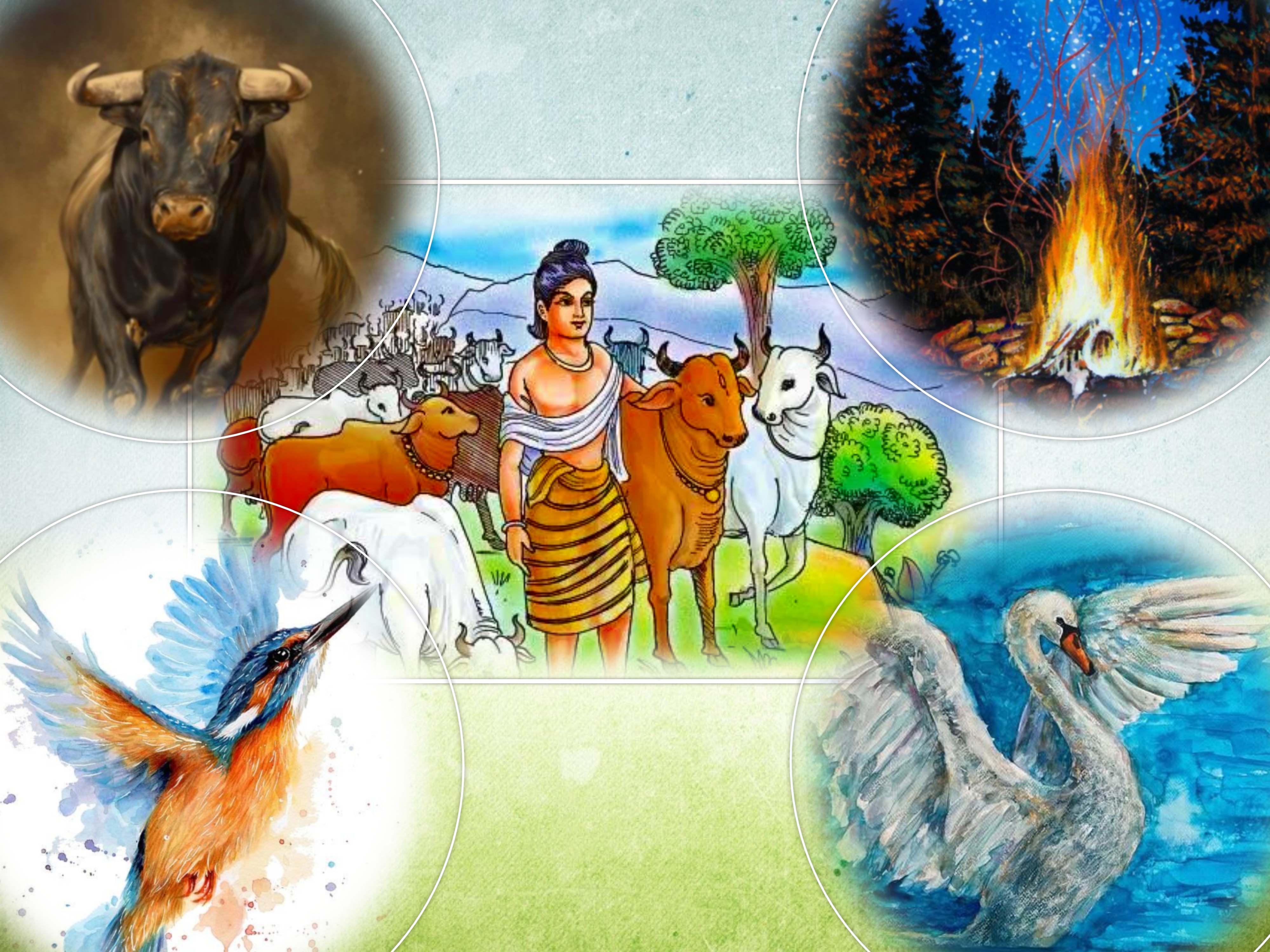- Visitor:33
- Published on:
Satyakam Jabala and the knowledge of four feet of Brahman
Nature by itself is a great educator where its every object is an open book. Here, the motivation and real desire of the learner matters to inquire about the right message and then think upon it. However, at present, our lives in this modern world have lost its connection with nature and its underpinning wonders. Hence, we must search and re-establish our lives and vision through the constructive relationship with our environment in its purest form.

In the Bhagavat Gita, we see Arjuna moaning in front of Sri Krishna confessing, “O friend, you are speaking of controlling the mind, but it is very difficult for me to calm my mind. Same as the wind, I see that my mind is almost out of my control”.
In response, Krishna gives the solution to the problem saying, “You are absolutely right friend. But with habits, one can gradually achieve anything. The mind can also be tamed through repeated practice and detachment”.
This is the art of living. One has to learn and realize what is good and what is bad for oneself before judging and taking a step forward. Next, the thing understood to be truth is to be practiced and reflected within life. Thus, an individual can progress little by little. In ancient Bharat, people developed their own unique education system for shaping life in this way from childhood days. If anyone needs to participate in this world, he definitely requires learning the knowledge of money-making. However, if someone wants to become pure and bring welfare to the society, he needs to remove the elements that restrict the calmness of the mind like selfishness, selfishness, laziness and weakness. He has to come out as a brave, energetic and proficient one. And, these traits come easily through practicing self-control, discipline and sacrifice. Further, infinite potential awakens in a man, as he practices celibacy. As the inner power is awakened, one can achieve anything.
Now, who is there to teach us all these? Many times we are devoid of any ideal in life. Then, we try to incline towards others’ characters to shape our life. Ancient Indians had the Rishis, Munis, Acharyas and Sannyasis who had the knowledge of Brahman, the absolute truth. These people were entrusted with the responsibility of teaching and spreading Vedantic education. In the ashramas, the home of these Gurus, the boys used to live under their guidance and presence, learning both science and spirituality. Later on, they returned home after a certain time, mastering this knowledge useful for their both worldly and spiritual lives. Thus, under the light of education and life-influence of these teachers, the students turned into instruments to bring the proper welfare for both themselves and society. Also, they got a glimpse of Brahman in such an atmosphere and even tasted spiritual joy through their journey. Due to this, it made it possible for them to follow the path of life with a happy mind and hold on to highest ideals despite every type of temptation and adverse conditions. In the past, these hermitages of Rishi’s in the forests were main centers of studying and gaining Brahma Vidya, from where the holy knowledge was distributed to every sphere of the society. Here, we will narrate one such story of attaining Brahma vidya from the life of Sage Gautama and his devoted student Satyakama from Chhandogya Upanishad.
One day, Rishi Haridrumata Gautama sorted out four hundred weak and lean cows from his collection for Satyakama. “O dear, take these cattle to the forest and graze them”, ordered Gautama. Bowing down in submission Satyakama humbly replied, “Prabhu, till these animals multiply to thousand, I shall not come back”.
Satyakama moved to the forest and lived there looking after and taking care of his teacher’s animals. Years passed by and meanwhile, the figure of cows increased by a thousand. Suddenly one evening, a Vrishabha or bull came near him and said, “I am glad to come here and to inform you about the secret behind the first foot or quarter out of the complete quality of Brahman. He is Prakashavan or radiant and present at all cardinal directs- north, south, east, south. If you meditate on him in that form, you will also become glowing like him. The next part will be taught to you by Agni, the fire God. For now, we are thousand in number and take us to your teacher”. Hearing that, Satyakama, drove the herd towards his Guru’s home the next dawn. The forest was a four-day route from the ashrama. Every night wherever Satyakama took a rest on his way, he continued receiving the Brahmagyan or ultimate reality from the God who came in different forms.
Again, he brought all the animals together in the evening and fenced them. As he kindled a fire and added some fuel into it there and sat down desolated immersed in his own world keeping his backside towards the fire, at once the fire addressed him from behind. The god said, “The second quarter of Brahman is infinite or Anantavan found in every worldly body such as earth, atmosphere, sky and ocean! If you meditate on him in this form, you will also become endless. Next, you will face a Hans to understand the next quarter. Goodbye!”.
Astonished by the information and thinking about it inside, again, Satyakama drove all the animals before the morning to reach his destiny. In the same way, he again arranged the cows and lit a fire and at once a swan came flying to him and said, “Hello boy, today I will let you know about the third part of the chapter. Remember that Brahman is also Jyotishman or the effulgent one. To be like him, meditate on him in this form which is itself the source of light-fire, sun, moon and lightning. Next, a Madgu bird will reach you!”. In the same situation next day, a waterfowl came in front of him and said, “Meditate on Brahman present in all of us as the breath, eye, ear and mind, knowing him as Anatavan or all-supporting, if you want to be like him. This is the final lesson for becoming a complete Brahmajnani. Bye!”.

As soon as he reached Gautama’s home, the old man was pleased how the boy has taken care of the cows and at the same time, more amazed by seeing the shine of enlightenment coming out of Satyakama’s face. He could not resist himself to ask curiously, “What is making you so much bright today. This Brahmashri on your face is a clear indication of inner knowledge of Brahman. Who taught you this?”.
Satyakama returned his master’s properties and himself prostrated at his feet. Recalling all the incidents and mentioning about his four new Gurus he met on road, he requested Gautama saying, “My respected Acharya, anything can happen by your grace. Kindly elaborate me the secrets behind all those facts that I have heard. I know, if I learn this Brahma Vidya from my own Guru directly, then this realization will be perfect”.
Being happy with his student, the Guru assured, “I will definitely teach you the same thing and this time, my boy, will add more meaning for you to all the facts that you have known till now”. Yes, Satyakama eventually received the full training and knowledge of Brahmavidya and in due course of time, he himself tuned into a great teacher of illuminated soul in his later days. This proves the line from our ancient scriptures- “Let good thoughts come from all directions!”. And, this was the prevailing education system of India that time.
Above all, the most important message from this story is that human beings can gain wisdom and knowledge from any source. Nature by itself is a great educator where its every object is an open book. Here, the motivation and real desire of the learner matters to inquire about the right message and then think upon it. If one is a true seeker, then knowledge not only comes from reading scriptures, teachers’ mouths, arguments, perceptions but also from various objects present in this world. So, the message matters the most not the messenger. However, at present, our lives in this modern world have lost its connection with nature and its underpinning wonders. Hence, we must search and re-establish our lives and vision through the constructive relationship with our environment in its purest form.
References:
Golpe Vedanta, Swami Viswasrayananda
Story of Jabala Satyakama
https://www.pallikkutam.com/edu-news/animals-and-birds-as-teachersthe-story-of-satyakama-jabala
https://www.linkedin.com/pulse/nature-great-educator-story-satyakam-jabal-raj-sharma/
Center for Indic Studies is now on Telegram. For regular updates on Indic Varta, Indic Talks and Indic Courses at CIS, please subscribe to our telegram channel !
- 16 min read
- 0
- 0










